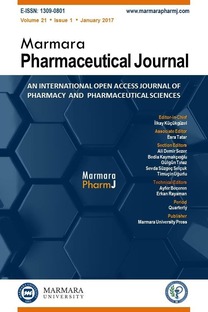Development and validation of a GC-FID method for determination of cocaine in illicit drug samples
___
[1] Benowitz NL. Clinical Pharmacology and Toxicology of Cocaine. Pharmacol Toxicol. 1993;72(1): 3-12.[2] United Nations Office on Drugs and Crime, Recommended methods for the identification and analysis of cocaine in seized materials. 2012 https://www.unodc.org/documents/scientific/Cocaine_Manual_Rev_1.pdf (accessed January 18, 2018).
[3] Simon DP, Kreek MJ, Cocaine: Usage, Misuse, and Addiction Processes. An Overview, In: Neuropathology of Drug Addictions and Substance Misuse. 2016.
[4] Dasgupta A. Pharmacology of Commonly Abused Drugs, In: Beating Drug Tests and Defending Positive Results. Springer Science+Business Media, LLC 2010, pp. 17-29.
[5] Steketee JD. Cortical mechanism of cocaine sensitization. Crit Rev Neurobiol. 2005; 17(2): 69–86.
[6] Debruyne D, Le Boisselier R. Emerging drugs of abuse: current perspectives on synthetic cannabinoids. Subst Abuse Rehabil. 2015; 6: 113–129.
[7] The EMCDDA annual report 2010: the state of the drug problem in Europe. Euro Surveil 2010; 15(46): pi=19714.
[8] Department of Anti Smuggling and Organized Crime Turkish Monitoring Centre for Drugs and Drug Addiction, 2017 Turkish Drug Report, http://www.narkotik.pol.tr/TUBIM/Documents/TURKIYE%20UYUSTURUCU%20RAPORU%202017.pdf (accessed January 18, 2018).
[9] Tosato F, Rosa T, Morais CLM, Maldaner AO, Ortiz RS, Filgueiras PR, Lima KMG, Romão W. Direct quantitative analysis of cocaine by thin layer chromatography plus a mobile phone and multivariate calibration: a cost-effective and rapid method. Anal Methods. 2016; 8(42): 7632-7637.
[10] Sabino BD, Romão W, Sodré ML, Correa DN, Alonso FOM, Eberlin MN. Analysis of cocaine and crack cocaine via thin layer chromatography coupled to easy ambient sonic-spray ionization mass spectrometry. Am J Analyt Chem. 2011; 2(6): 658-664.
[11] Magalhães EJ, Nascentes C, Pereira LSA, Guedes MLO, Lordeiro RA, Auler LMLA, Augusti R, Queiroz MELR. Evaluation of the composition of street cocaine seized in two regions of Brazil. Sci Justice. 2013;53(4):425–432.
[12] Botelho ED, Cunha RB, Campos AFC, Maldaner AO. Chemical profiling of cocaine seized by Brazilian federal police in 2009–2012: major components. J Br Chem Soc. 2014;25(4): 611–618.
[13] Valente MJ, Carvalho F, Bastos M de L, Carvalho M, and de Pinho PG. Chromatographic Methodologies for Analysis of Cocaine and Its Metabolites in Biological Matrices, In: Salih B. (Eds). Gas Chromatography - Biochemicals, Narcotics and Essential Oils, Intech, 2012, pp.163-194 https://www.intechopen.com/books/gaschromatography-biochemicals-narcotics-and essential-oils/chromatographic-methodologies-for-analysis-ofcocaine-and-its-metabolites-in-biological-matrices (accessed January 18, 2018).
[14] Keyfi F, Varasteh A. Development and Validation of a GC-FID Method for Diagnosis of Methylmalonic Acidemia. Rep Biochem Mol Biol. 2016;4(2): 104-109.
[15] Taylor T. GC Temperature Programming—10 Things You Absolutely Need to Know. LCGC North America. 2015;33(6): 438.
[16] International Conference on Harmonization (ICH), ICH (Q2 (R1); Validation of Analytical Procedures: Text and methodology. International Conference on Harmonization, Geneva, Switzerland, 2005.
[17] A WHO Guide to Good Manufacturing Practice (GMP) Requirements, Part 2: Validation, World Health Organization, Geneva, 1997 http://apps.who.int/iris/bitstream/handle/10665/64465/WHO_VSQ_97.02.pdf;jsessionid=D280DE3CAE2580E3 2A03B0095D8CDDAC?sequence=2
[18] Al-Rimawi F, Kharoaf M. Analysis of Azithromycin and Its Related Compounds by RP-HPLC with UV Detection. J Chromatogr Sci. 2010;48(2): 86-90.
[19] Arslan Azizoğlu G, Azizoğlu E, Tuncay Tanrıverdi S, Özer Ö. A validated HPLC method for simultaneous estimation of Melatonin and Octyl Methoxycinnamate in combined pharmaceutical applications. Marmara Pharm J. 2017;21(4): 921-930.
[20] Yeager B, Bustin K, Stewart J, Dross R, Bell S. Evaluation and validation of ion mobility spectrometry for presumptive testing targeting the organic constituents of firearms discharge residue. Anal Methods. 2015; 7(22): 9683-9691.
- ISSN: 1309-0801
- Yayın Aralığı: 6
- Başlangıç: 1985
- Yayıncı: Marmara Üniversitesi
Gopikrishna YENDURI, Srinivasu NAVULURI
Sakine ATİLA KARACA, Duygu UĞUR YENİCELİ
Ebru TÜRKÖZ ACAR, Sinem HELVACIOĞLU, Mohammad CHAREHSAZ, Ahmet AYDIN
Ahmet HAŞİMOĞLU, Shantanu B. GHODKE
The role of the pharmacist from development to pharmacovigilance of biosimilars
İmge KUNTER, Halimat Olusola BALOGUN, Gönül Zişan ŞAHİN
Mustafa ÇELEBİER, Engin KOÇAK, Ayşegül DOĞAN, Sacide ALTINÖZ, Nursabah Elif BAŞCI
Synthesis and evaluation of new benzoxazole derivatives as potential antiglioma agents
MEHLİKA DİLEK ALTINTOP, Gülşen AKALIN ÇİFTÇİ, Halide TEMEL EDİP
Muhammed İhsan HAN, Hatice BEKÇİ, Ahmet CUMAOĞLU, Ş. Güniz KÜÇÜKGÜZEL
Evren Homan GÖKÇE, Mustafa Sinan KAYNAK, Aysu YURDASİPER, Neslihan ÜSTÜNDAĞ-OKUR
Formulation optimization and evaluation of Cefdinir nanosuspension using 23 Factorial design
Omkar A. PATIL, Indrajeet S. PATIL, Rahul U. MANE, Dheeraj S.RANDIVE, Mangesh A. BHUTKAR, Somnath D. BHINGE
